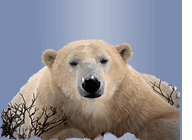 |
|
|
| |
|
|
|
|
|
|
|
|
|
|
| Asiatic Black Bears |
|
|
|
|
|
|
|
| |
BearPlanet Mission
|
Our mission is to:
- take care for all species of Bears.
- to educate visitors about all aspects and attributes of Bears
If you are webmaster please show us your support by linking to our website:
<a href="http://www.bearplanet.org"
title="Kodiak: Grizzly, Panda, Polar Bear">Bears - BearPlanet.org</a>
|
|
|
 |
|
The Asiatic Black Bears
|
|
The Asiatic Black Bear is in many ways very similar to its cousin, the American black bear.
It has several alternative names, including Himalayan black bear, Tibetan
(Ursus thibetanus means bear of Tibet) and moon bear, after the white marking
on its chest.
Asiatic black bear (Ursus thibetanus),
is the most common bear (mainly localised in the Himalayas).
It inhabits mountain forests from Afghanistan to the islands of Japan and they are good tree climbers spending
much of their time in trees in search of acorns and other nuts.
The Asiatic Black Bear habitat is often at altitudes
of more than 13,000 feet in the Himalayas.
It displays a necklace of white fur across its chest and thick, long black ruff on its neck.
Its medium-length body hair is jet black.

Like their American black bear cousins,
Asiatic black bears are generalists too. For example in Iran they feed on
olives, figs, insects and the buds of the date palm and come into conflict with farmers when they climb the palm trees.
For that reason, these black bears have been hunted almost to extinction in the Middle East, and they are almost
never seen, with probably only about 20 - 30 remaining in Iran.
They are generally considered as a pest species and over 100 black bears
are killed annually:
trapped in cages and then shot.
Asiatic black bears are declining in numbers and because of this fact that
they are killed for the rarity of their body parts. People will pay a lot of money for bear paws, which
are considered a delicacy, and for their gall bladders which are thought to be a powerful medicine.

These animals have the usual strong bear-like figure with a large head and small eyes.
The size of the Asiatic black bear is between 130 to 190 centimetres. Males and females differ clearly in their weight.
While male animals reach 110 to 200 kilograms, female animals weigh only 50 to 125 kilograms.
|
|
|
 |
Asiatic black bear Fact

- Name: Asiatic black bear (Ursus thibetanus)
- Kingdom: Animalia
- Phylum: Chordata
- Subphylum: Vertebrata
- Class: Mammalia
- Subclass: Theria
- Order: Carnivora
- Family: Ursidae
- Length of life: About 30 years in zoos. In the wild unknown
- Size: 130 to 190 cm
- Weight: 100 to 200 kg males
50 to 125 kg females
- Habitat: Forest areas in hills and mountains
- Diet: Bees nests, insects, small vertebrates, invertebrates, fruit, carrion
- Gestation: 4 to 6 months
- Cubs: 1 to 2 cubs
- SubFamily: Ursinae
- Genus: Ursus
- Predators: Humans, packs of wolves, leopards, dholes, tigers (occasinally) lynxes (prey on cubs)
- Distribution: From Southheast Asia and Northeastern China and Taiwan to Southheast Russia and the Japabese islands of Honshu and Shikoku
|
 |
| |
|
|
|